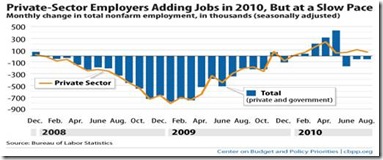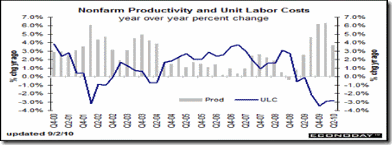The August unemployment report supported both sides of the stimulus debate. Democrats said it showed more stimulus was needed, while Republicans said employers were holding back because of too much government—too many regulations and a soaring deficit meant higher taxes down the road. Yet jobs are returning, in spite of the political gridlock. But with all the doom and gloom, one has to look closely at the numbers to see this.
Overall payroll employment fell 54,000 for the third straight month in August, though there was a moderate gain in the private sector, with private job hiring rising 67,000. Also on the positive side, wages were up. And the companion Household Data survey that actually computes the unemployment rate (9.6 percent) showed 886,000. additional “private wage and salary workers in all nonagricultural industries except private households”. And the May-August monthly average of 285,000 was only slightly down from the January-April average of 328,000. It tracks the self-employed as well as payroll workers, hence may be a more accurate measure of employment.
In fact, there is no evidence that a fear of higher taxes (for the wealthiest) deters employers or consumers. More than 23 million jobs were created during the Clinton years, when tax rates for the wealthiest were higher. This brought the unemployment rate below 5 percent and the first budget surplus in a generation by 1998. Everyone is hewing to their ideological lines during this election year, in other words, regardless of the realities.
The realities are that employers are trying to squeeze maximum profits from their existing workforce, but that is no longer working. The best evidence for this is the latest labor productivity report that indicated very little additional output was coming from the existing workforce while labor costs were rising. Ergo, workers want more pay and benefits for even a small additional increase of output. And so employers must begin to hire more workers, if they want to keep their productions costs down.
Average hourly earnings improved to 0.3 percent from up 0.2 percent in July. The August number topped the market estimate for a 0.1 percent gain. The average workweek for all workers was unchanged at 34.2 hours in July. The market forecast was for 34.2 hours.
But incomes are still barely rising, which is hurting demand for more goods and services. Due to the slowdown in output and businesses already having cut labor costs to the bone, productivity fell notably in the second quarter. Nonfarm business productivity declined an annualized 1.8 percent in the second quarter after a 3.9 percent advance in the prior quarter.
Unit labor costs (i.e., costs per worker) rebounded an annualized 1.1 percent in the second quarter, following a drop of 4.6 percent in the first quarter. Year-on-year, productivity was up 3.7 percent in the second quarter-down from 6.3 percent in the previous quarter. This is still a good number, and way above the longer term 2.5 percent productivity growth average.
So where and when will employers hire enough workers to begin to bring down the current 9.6 percent unemployment rate? They would have to more than double current numbers—to 125-150,000 new payroll jobs per month just to keep up with new workers entering the jobs market, according to the Establishment payroll survey.
Both the manufacturing and service sectors are still expanding, per the Institute of Supply Management (ISM), with manufacturing activity up most in the August survey. Private service providing jobs rose 67,000 after a 70,000 boost in July, with a 45,000 boost in education & health services, and health care is up 40,000. Goods-producing jobs were unchanged in August after a 37,000 advance in July, but that will probably also rise next month, with the new ISM data.
So we know that employers will begin hiring again, with the continued growth in both sectors, but without rising wages it won’t boost economic growth. More stimulus is needed, such as better social safety net programs for those who have to accept jobs for lesser pay during recessions—which is one reason demand has fallen so sharply during this recession?
One suggestion from former Labor Secretary Robert Reich is an “earnings insurance” that will pay the difference between old and new salaries for 2 years, similar to Germany’s, which has kept their unemployment rate around 8 percent. It would be cheaper than extended unemployment insurance, he maintains, and put more people back to work.
The bottom line is as Professor Reich says in his most recent New York Times op-ed—income inequality today equals that of 1928. And in both 1928 and 2008, the richest 1 percent of American households took in 23.5 percent of total income, whereas it was just 9 percent in the 1970s. The median (i.e., middle class) male worker earns less today when adjusted for inflation that he did 30 years ago. No economy can grow unless we bring back the middle class, in other words.
Harlan Green © 2010



No comments:
Post a Comment